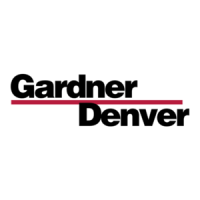Do you have a question about the Gardner Denver ELECTRA-SCREW EBE DH-15 HP and is the answer not in the manual?
Overview of Electra-Screw stationary base-mounted and tank-mounted compressors.
Explains DANGER, WARNING, CAUTION, and NOTICE meanings for hazard communication.
Details the meshing helical rotors and compression cycle of the compressor.
Describes the path of air through the compressor system components.
Explains the role of oil in cooling, lubricating, and sealing the compressor.
Essential safety measures including electrical, grounding, and lockout/tagout procedures.
Identifies critical danger and warning labels related to operation and hazards.
Covers unit inspection, lifting, and placement recommendations.
Specifies ideal installation locations and airflow needs for air-cooled units.
Guidance for installing units in cold climates and enclosure considerations.
Details control piping requirements and standard electrical wiring connections.
Covers essential grounding procedures and electric motor lubrication recommendations.
Steps for checking oil, filters, piping, electrical, and grounding before operation.
Guides on how to start the unit in cold and hot conditions and how to stop it safely.
Describes the standard control system for load/unload and lead/lag operations.
Explains overload protection, differential pressure monitoring, and temperature sensing.
Details the operation of the inlet valve and blowdown valve.
Describes components like inlet valve, blowdown valve, and minimum pressure/check valve.
Details the hourmeter, Auto-Sentry S controller, and emergency stop pushbutton.
Explains the function of CONSTANT RUN, AUTO LEAD, and AUTO LAG buttons.
Describes the meaning of LEDs like HIGH TEMPERATURE, MOTOR OVERLOAD, CHANGE SEPARATOR, CHANGE AIR FILTER.
Explains how to read pressure/temperature displays and error messages.
Step-by-step guide to programming the unit's load and unload pressure setpoints.
Instructions for setting up and operating two compressors in a lead-lag configuration.
Explains the function and adjustment of the subtractive pilot for capacity control.
Overview of the oil system components and their functions in cooling and lubrication.
Details Gardner Denver's recommended lubricants and their properties.
Guidance on lubricant use during high temperatures and the procedure for changing lubricants.
Advice for cold weather operation and checking/adding oil levels.
Discusses potential moisture issues and how to read oil level sight gauges.
Details oil change intervals based on temperature and procedures for draining the system.
Instructions on servicing and replacing the compressor oil filter element.
Procedures for checking oil and air discharge temperatures and oil inlet pressure.
Emphasizes the importance of proper air filter maintenance for unit performance.
Details servicing procedures for the heavy-duty washable air filter element.
Instructions for servicing the optional standard duty air filter element.
Guidance on filter element lifespan and conditions requiring replacement.
Procedures for checking drive belt tension and alignment for optimal performance.
Outlines service checks for 8, 125, 1000, 4000 hours, and yearly maintenance.
Common causes and remedies for compressor failure to start or short run times.
Troubleshooting for issues related to compressor loading, unloading, and excessive cycling.
Addresses causes for low delivery pressure and high discharge air temperatures.
Troubleshooting for excessive oil consumption and oil carry-over problems.
Solutions for the "Change Separator" indicator light during startup and operation.
Troubleshooting for motor overload shutdowns and persistent air filter change lights.
Diagnosing and resolving incorrect pressure readings and oil leaks at the seal housing.
Outlines limitations, exclusions, and general terms of the product warranty.
Specifies warranty duration for compressor air ends and other components.
Legal disclaimer regarding expressed, implied, or statutory warranties.
| Category | Compressor |
|---|---|
| Horsepower | 15 HP |
| Type | Rotary Screw |
| Brand | Gardner Denver |
| Model | EBE DH-15 HP |












